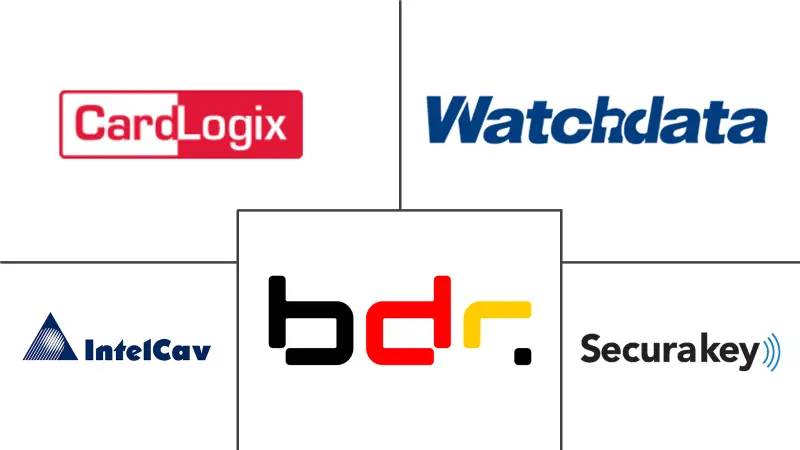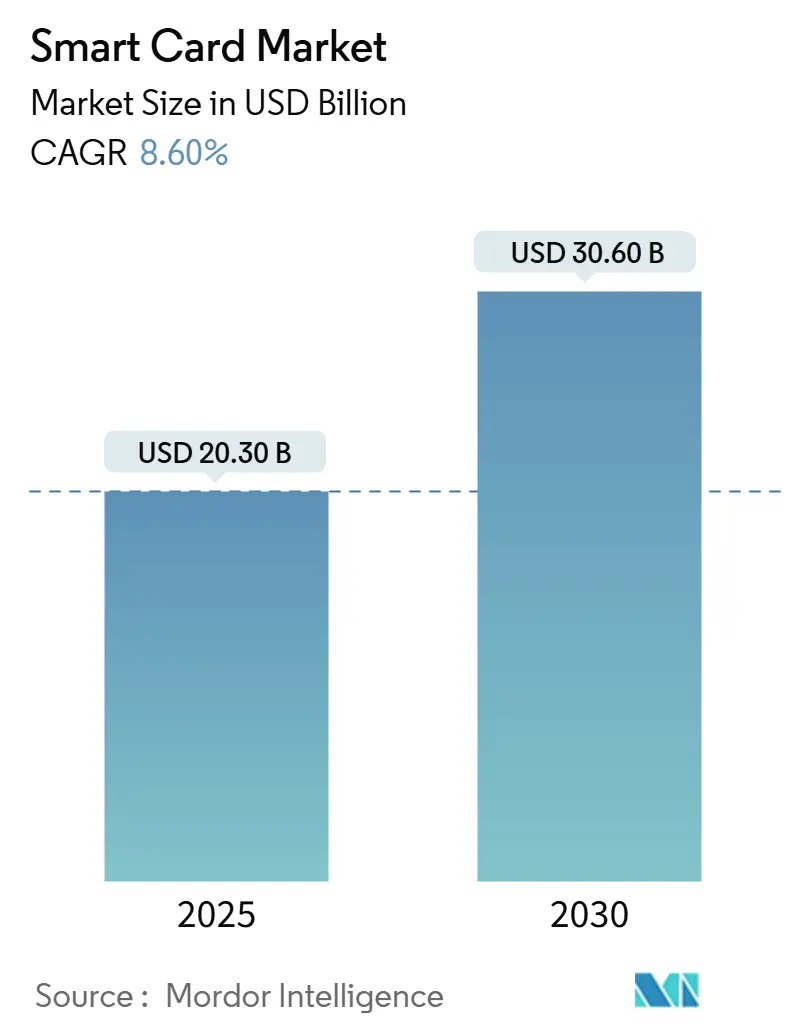
Smart Card Market Analysis by Mordor Intelligence
The smart card market size stands at USD 20.3 billion in 2025 and is projected to reach USD 30.6 billion by 2030, advancing at an 8.6% CAGR through the forecast period. Consistent migration to EMV, expanding national digital-identity programs, and rising demand for multi-application credentials continue to anchor growth. Contactless technology is now mainstream in retail payments, while dual-interface cards offer an incremental upgrade path for issuers that still maintain legacy contact-only estates. Secure elements on cards are witnessing rapid uptake as governments and enterprises converge physical and digital identity, a trend that creates adjacent opportunities in cybersecurity services. Regionally, Asia commands the largest installed base, yet the deepest expansion runway lies in Africa, where mobile-first payment ecosystems unlock card issuance at previously untapped customer tiers. Competitive intensity is moderate; tier-one manufacturers are consolidating share through sustainability-linked products and biometric innovations that create differentiation beyond price.
Key Report Takeaways
- By interface type, contactless cards led with 54% of the smart card market share in 2024; dual-interface cards are forecast to expand at an 8.7% CAGR to 2030.
- By chip type, microcontroller cards accounted for 62% share of the smart card market size in 2024; secure element-based cards are set to grow at a 10.2% CAGR through 2030.
- By material, PVC dominated with 42.95% market share in 2024; polycarbonate is projected to progress at an 8.3% CAGR to 2030.
- By application, payment & banking captured 45.07% of the smart card market size in 2024; identification and eID cards are poised for a 10.37% CAGR.
- By end-user industry, telecom held 44.43% share of the smart card market size in 2024; BFSI is expected to record the highest 9.83% CAGR.
- By geography, Asia led with 44% of the smart card market share in 2024, while Africa is on track for the fastest 9.3% CAGR between 2025 and 2030.
Global Smart Card Market Trends and Insights
Drivers Impact Analysis
| Driver | (~) % Impact on CAGR Forecast | Geographic Relevance | Impact Timeline |
|---|---|---|---|
| Contactless EMV migration | +1.8 | Asia (China, India, ASEAN) | Short term (≤ 2 years) |
| EU and GCC eID and digital health roll-outs | +1.2 | Europe, Middle East (GCC) | Medium term (2-4 years) |
| Pre-paid SIM expansion | +0.9 | South America (Brazil, Argentina) | Medium term (2-4 years) |
| EU eIDAS-2.0 wallet adoption | +1.5 | Europe | Medium term (2-4 years) |
| Sustainable card materials | +0.7 | Global (led by Europe, North America) | Long term (≥ 4 years) |
| Biometric FIDO2 on-card authentication | +0.6 | Nordics, Japan, South Korea | Long term (≥ 4 years) |
| Source: Mordor Intelligence | |||
Contactless EMV Migration in Emerging Asian Economies
Roll-out momentum accelerated in 2024 as Bangladesh and Nepal commissioned local EMV Level 3 test labs that shorten certification cycles and cut issuer costs. China saw a 37% annual rise in contactless transactions, while India logged 42% growth in issuance, figures that reflect the mainstreaming of tap-to-pay and underscore the addressable base for terminal upgrades. Banks frame contactless issuance as a retention lever in overcrowded retail markets, and merchants benefit from faster checkout speeds that lift throughput. With EMV-enabled cards already accounting for 70% of global issuance, Asian issuers are positioned to leapfrog directly to dual-interface portfolios. Near-term sales growth, therefore, skews toward secure microcontroller cards able to support value-added services such as transit ticketing and small-value offline payments.
EU & GCC National eID and Digital Health Card Roll-outs
Implementation of the EU Digital Identity Regulation in May 2024 obliges member states to provide physical and mobile credentials in parallel, sustaining demand for high-security polycarbonate cards.[1]Thomas Elis, “EU Digital ID Regulation Mandates Member States to Provide Digital Identity Wallets for Citizens,” techuk.org GCC countries follow a similar path as they modernize healthcare delivery and border-control frameworks. Polycarbonate inlays such as CoreLam are now deployed in 20+ national programs. Manufacturers gain from multi-year supply contracts that favor vertically integrated players capable of personalisation, key management, and secure applet loading. Because wallet adoption will take time, physical eID issuance remains a mandatory fallback, locking in baseline unit volumes during the transition period.
Pre-paid SIM Expansion Driving Secure Elements in Latin America
E-SIM availability now spans 90% of Latin American markets, yet large prepaid segments still rely on physical UICC cards, creating a dual-technology environment.[2]Medeiros, Hyggor da Silva, Leandro de Souza Bezerra, Fernando Trinidad España, and Jefferson Tiago Santos de Oliveira, "Embedded-SIM (E-SIM) an Overview in Latin America: Implementation, Availability, Advantages and Disadvantages." Journal of Communication and Information Systems, jcis.sbrt.org.br Mobile network operators hedge risk by procuring both eSIM profiles and next-generation secure elements that can operate in removable or embedded modes. Card makers with eUICC-certified operating systems consequently secure share, while semiconductor vendors benefit from incremental secure-element die demand. The coexistence model is expected to persist through the medium term as smartphone penetration continues to vary across urban and rural areas.
EU eIDAS-2.0 digital wallet regulation adoption
The May 2024 legal act mandates EU-wide Digital Identity Wallets by 2026, elevating secure-element demand because hardware-backed security is central to certification benchmarks under development at ENISA.[3]European Union Agency for Cybersecurity, "EU Digital Identity Wallet: A leap towards secure and trusted electronic identification through certification.", enisa.europa.eu GlobalPlatform has already identified SEs as the optimum anchor for credential storage. National agencies, therefore, launch procurement rounds for cards that double as authentication tokens in wallet ecosystems. Suppliers able to offer converged form factors - physical card plus NFC-enabled applet - are well placed to win.
Restraints Impact Analysis
| Restraint | (~) % Impact on CAGR Forecast | Geographic Relevance | Impact Timeline |
|---|---|---|---|
| Tokenised virtual cards | −1.2 | North America, Europe | Medium term (2-4 years) |
| Secure MCU supply-chain volatility | −0.8 | Global | Short term (≤ 2 years) |
| GDPR-driven delays in cross-border issuance | −0.5 | Europe (multinational issuers) | Medium term (2-4 years) |
| Fraud migration to CNP channels | −0.7 | North America | Short term (≤ 2 years) |
| Source: Mordor Intelligence | |||
Rise of Tokenised Virtual Cards Reducing Physical Demand
Virtual card transactions are forecast to quadruple to more than 121 billion by 2027, while Mastercard targets 100% e-commerce tokenisation in Europe by 2030. The shift diverts issuer budgets toward digital engagements and shrinks replacement cycles for low-value debit portfolios. Physical cards remain essential for face-to-face acceptance and offline fallback, yet the share of wallet could tilt toward virtual instruments in mature markets, dampening unit growth.
Secure MCU Supply-chain Volatility
Automotive semiconductors are absorbing capacity at a projected 10% CAGR through 2030, squeezing secure MCU allocation for card vendors. Despite USD 2.3 trillion committed to new fabs, near-term lead times remain extended. Market leaders such as IDEMIA mitigate risk through direct foundry relationships and modular chip designs. Smaller card assemblers without captive supply confront cost spikes that compress margins.
Segment Analysis
By Interface Type: Contactless Remains Dominant while Dual-interface Accelerates
Contactless cards accounted for 54% of the smart card market size in 2024, reaffirming their status as the de facto form factor for everyday payments. Dual-interface issuance is rising at an 8.7% CAGR as issuers seek backward compatibility with legacy contact-only terminals without compromising tap-to-pay functionality. Innovations such as the EMV C-8 universal kernel reduce terminal certification complexity and catalyse acceptance expansion. In parallel, chipset improvements from Infineon shorten transaction time, improving user experience in high-throughput retail environments.
Issuer appetite for contact-only cards persists in government and defence, where a physical interface adds a security layer against relay attacks. Hybrid cards, embedding multiple technologies on a single substrate, satisfy niche enterprise requirements for logical and physical access convergence. The competitive narrative, therefore, shifts from mere interface type to value-added capabilities such as biometric match-on-card and post-issuance personalisation, themes that enable vendors to defend margins in the smart card market.
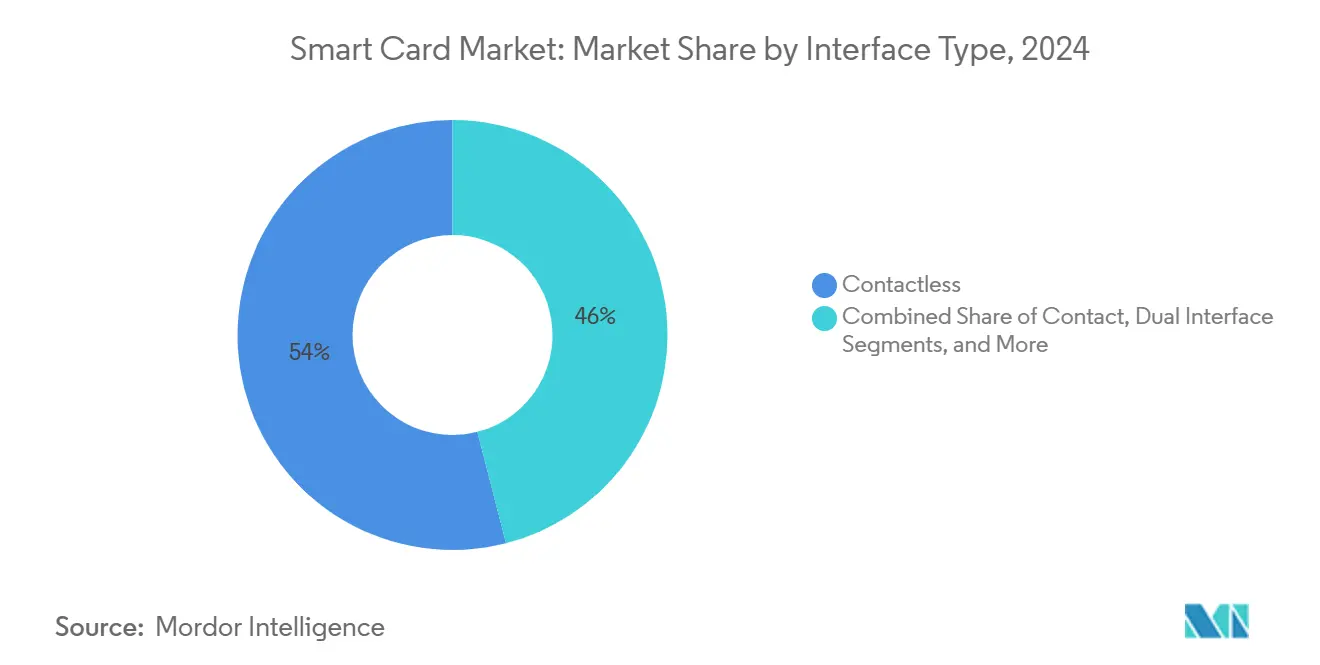
Note: Segment shares of all individual segments available upon report purchase
By Card Chip Type: Microcontrollers Lead as Secure Elements Surge
Microcontroller cards captured 62% of the smart card market share in 2024, reflecting their versatility across payments, telecom, and identity use cases. Secure element cards, however, are expanding at a 10.2% CAGR thanks to heightened cryptographic requirements in eID and digital-wallet ecosystems. The SECORA Pay Bio turnkey platform exemplifies how sensor integration and secure elements can be bundled to compress the bill-of-materials and time-to-market.
Memory-only cards remain relevant for mass transit and prepaid gift applications where cost sensitivity outweighs processing needs. Ultra-thin modules such as NXP’s MOB10 unlock new passport applications by improving durability against bending stress. Overall, the product-mix shift toward secure elements benefits semiconductor suppliers with certified Common Criteria product lines, sustaining a technology-led competitive moat within the smart card market.
By Material: PVC Holds Scale while Polycarbonate Gains Momentum
PVC retained 42.95% dominance in 2024 due to its low cost and well-established production tooling. Polycarbonate grows at 8.3% CAGR as governments opt for laser-engraved data pages that resist tampering. Banking issuers are experimenting with polylactic acid cards that cut virgin PVC by 80%.
Metal and composite cards occupy the premium segment, serving affluent consumer propositions that emphasize perceived value and durability. Vendors such as CompoSecure have shipped more than 200 million metal units since 2010, signaling scalable demand for differentiated materials.[4]CompoSecure, “2024 Form 10-K,” sec.gov Material choice thus becomes a lever for issuers to align sustainability, branding, and security objectives in an increasingly segmented smart card market.
By Function/Application: Payment Dominates as eID Accelerates
Payment and banking applications represented 45.07% of the smart card market in 2024 and continue to anchor annual volume. Regulatory pushes in Europe and the GCC, coupled with national healthcare programs, are propelling eID cards at a 10.37% CAGR. Biometric authentication, once confined to pilot projects, now features in mainstream access-control deployments across Spain and Portugal.
Telecom SIM cards remain essential despite eSIM gains, as emerging markets still rely on removable form factors for device compatibility. Transit operators across 1,000 cities have adopted open-loop fare systems, embedding payment applets directly onto general-purpose cards. Diversified applications secure baseline growth even as digital alternatives proliferate.
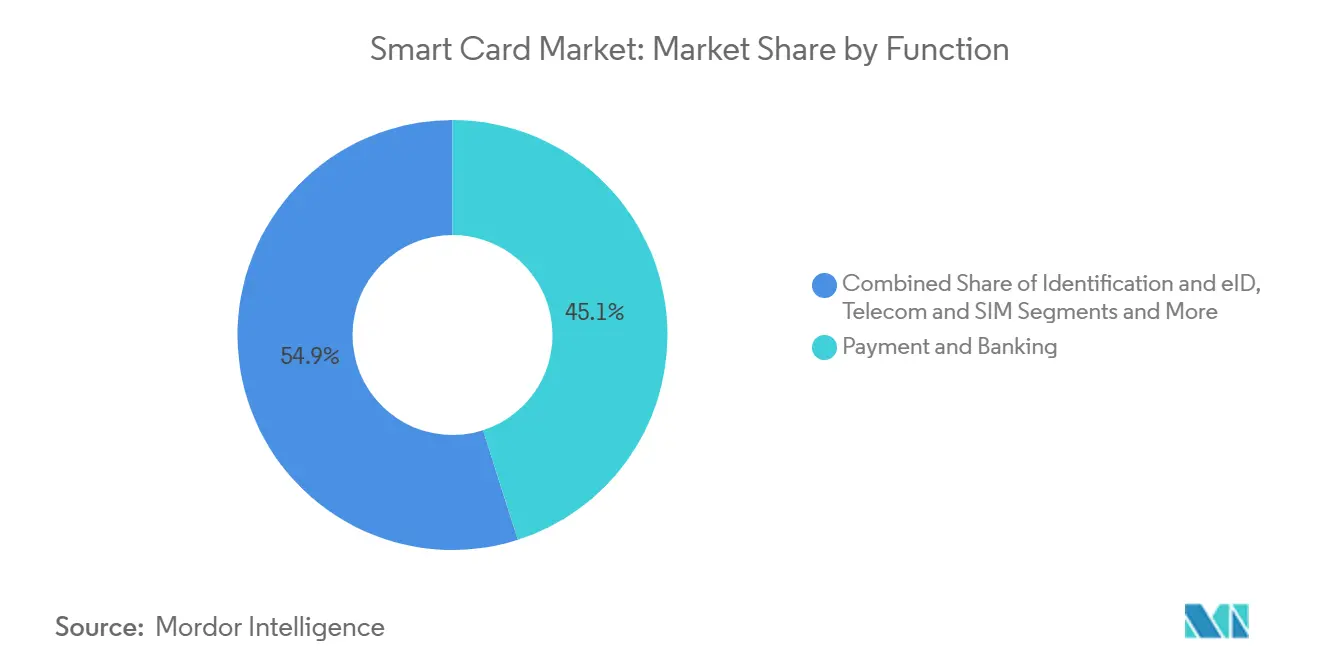
Note: Segment shares of all individual segments available upon report purchase
By End-user Industry: IT and Telecom leads, BFSI Grows Fastest
IT and Telecom secured 44.4% of the smart card market size in 2024, underpinned by prepaid SIM demand and IoT connectivity. The BFSI segment, advancing at a 9.83% CAGR, invests in metal and biometric cards to boost customer advocacy, which correlates with 1.7× revenue growth among top-quartile banks.
Government projects expand steadily with national ID and social-security programs. Healthcare gains momentum via digital-health-card initiatives designed to unify insurance data and vaccination records. Retailers leverage co-branded loyalty cards with contactless payment capabilities, reinforcing omnichannel engagement and data collection strategies in the smart card market.
Geography Analysis
Asia led the smart card market with 44% revenue share in 2024, anchored by rapid EMV penetration and national ID issuances. Contactless transactions in China rose 37% year-on-year despite coexistence with QR payment ecosystems.[5]National Business News, "From payment tools to the 'digital key' smart card market of the Internet of Everything passes through the cycle and grows resilient.", wangwenlin.com India logged 42% growth in contactless card issuance, though rural infrastructure gaps temper full-scale adoption. Japan, responding to a 30% spike in credit-card fraud, is piloting biometric payment cards and expects contactless payment value to reach USD 870 billion by 2028.[6]IDEX Biometrics, "IDEX Biometrics partners with KONA I to launch biometric cards globally." Inderes, inderes.dk
Europe holds second place by value. The eIDAS-2.0 mandate drives both physical and digital identity demand, while Nordic enterprises pioneer FIDO2 hardware keys. GDPR-linked complexity delays multi-country issuance platforms, nudging issuers toward domestically hosted personalization centres. Mastercard’s commitment to full tokenisation by 2030 signals a gradual pivot to digital credentials, yet physical cards remain obligatory for offline verification and multi-channel access.
Africa is the fastest-growing region at a 9.3% CAGR. Mobile-money services processed transactions worth USD 1.68 trillion in 2024, catalysing demand for companion debit cards. South-African card payments will surpass USD 158 billion in 2025, while Egypt targets USD 104 billion in digital payments by 2030. Strategic alliances, such as Orange MEA and Mastercard, aim to digitize payments for 40 million users by 2025.[7]Mastercard, “A Guide to Issuing Sustainable Cards,” mastercard.com North America emphasizes digital-fraud mitigation, South America benefits from SIM expansion, and Australia prioritizes tokenisation under its 2025-2028 security roadmap, visa.com.au.
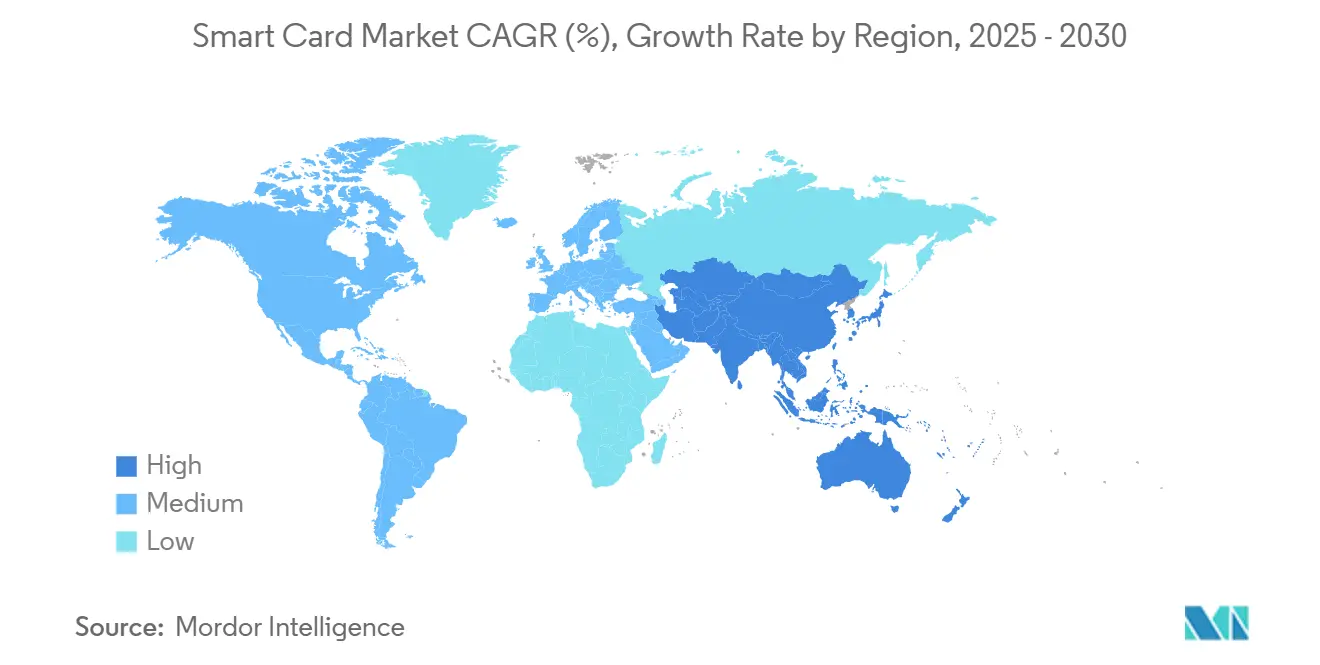
Competitive Landscape
The smart card market exhibits moderate concentration. Thales, IDEMIA, and Giesecke+Devrient leverage vertically integrated supply chains covering chip design, OS development, and personalization, enabling them to defend their share and scale sustainability initiatives. IDEMIA co-developed a hybrid metal card, “Feuille d’Émeraude,” enhancing differentiation in France’s premium segment.
Regional challengers gain traction through specialization. CPI Card Group recorded 26% prepaid revenue growth by bundling anti-fraud packaging with eco-focused substrates. CompoSecure dominates metal cards with cumulative shipments exceeding 200 million units, illustrating how material innovation creates high-margin niches. Fingerprint Cards and IDEX Biometrics supply sensors and biometric applets, partnering with top-tier card manufacturers to embed match-on-card capability.
Strategic moves focus on ecosystem partnerships and capacity hedging. Semiconductor alliances secure wafer supply, while certification labs expand regionally to reduce time-to-market. Entrants that couple secure hardware with cloud-based credential management enhance value propositions as the smart card market converges with digital identity platforms.
Smart Card Industry Leaders
-
CardLogix Corporation
-
Watchdata Technologies
-
Bundesdruckerei GmbH
-
IntelCav
-
Secura Key
- *Disclaimer: Major Players sorted in no particular order
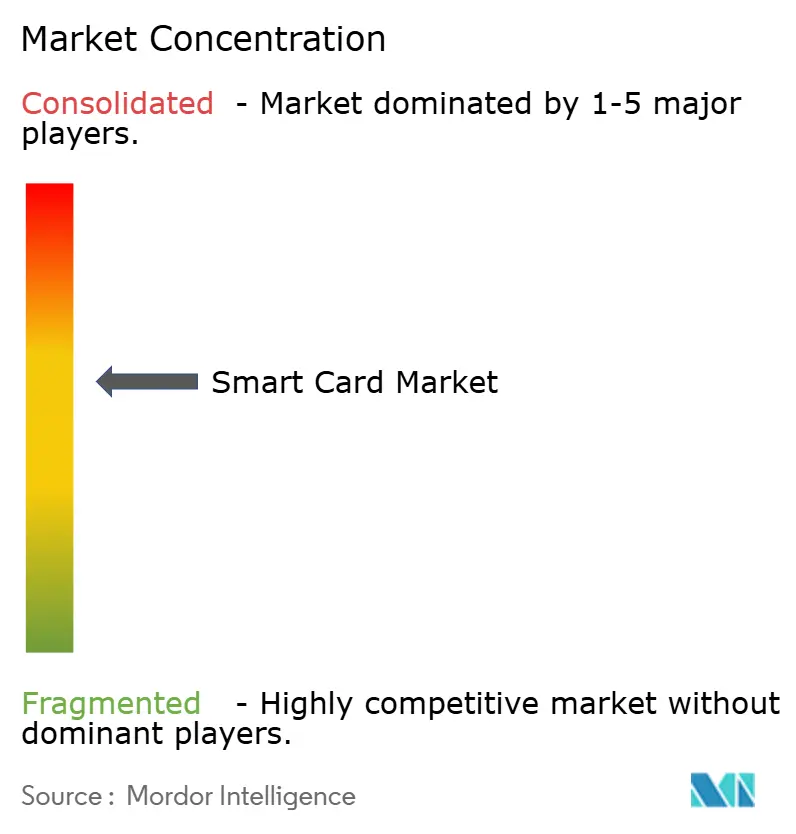
Recent Industry Developments
- January 2025: EMVCo confirmed nearly 14 billion EMV cards in circulation, with 95% of all card-present transactions EMV-compliant.
- December 2024: Sumeria and IDEMIA launched a hybrid metal payment card using Ultimate Metal Art technology in France.
- October 2024: Orange MEA partnered with Mastercard to digitize payments for millions across Africa by 2025.
- October 2024: Fime unveiled the first EMV C-8 contactless kernel testing service, streamlining terminal certification.
Research Methodology Framework and Report Scope
Market Definitions and Key Coverage
Our study defines the global smart card market as the annual revenues generated from newly issued, factory-programmed contact, contactless, dual-interface, and hybrid cards that embed a secure microcontroller or memory chip and are supplied for payment, identification, access control, telecommunications (SIM/eSIM), transportation ticketing, and healthcare authentication purposes.
Scope Exclusion: Modules sold as NFC tags, magnetic-stripe-only cards, SIM card service revenues, and purely virtual credentials are not included.
Segmentation Overview
- By Interface Type
- Contact
- Contactless
- Dual Interface
- Hybrid
- By Card Chip Type
- Memory
- Microcontroller
- Secure Element/System-on-Card
- By Material
- PVC
- Polycarbonate (PC)
- ABS
- PETG and Bio-based Plastics
- Metal and Composite
- By Function/Application
- Payment and Banking
- Identification and eID
- Access Control and Physical Security
- Telecom and SIM
- Transportation Ticketing
- Healthcare and Insurance
- Retail and Loyalty
- By End-user Industry
- BFSI
- IT and Telecommunications
- Government and Public Sector
- Transportation and Logistics
- Healthcare
- Retail and Hospitality
- Education and Others
- By Geography
- North America
- United States
- Canada
- Mexico
- Europe
- United Kingdom
- Germany
- France
- Italy
- Rest of Europe
- Asia-Pacific
- China
- India
- Japan
- South Korea
- Rest of Asia-Pacific
- South America
- Brazil
- Argentina
- Rest of South America
- Middle East
- GCC
- Turkey
- Rest of Middle East
- Africa
- South Africa
- Nigeria
- Kenya
- Rest of Africa
- North America
Detailed Research Methodology and Data Validation
Primary Research
We next interview smart card silicon designers, personalization bureaus, payment-scheme integrators, and national ID program managers across Asia, Europe, North America, and the Gulf. These discussions validate shipment seasonality, average selling prices, and migration rates toward dual-interface or biometric formats, allowing us to tighten model assumptions flagged during desk work.
Desk Research
Mordor analysts first build a reference library drawing on public trade statistics from bodies such as EMVCo, the Smart Payment Association, and UN Comtrade to gauge annual smart card unit flows. We complement these with policy papers from central banks, EU Digital ID directives, and transport authorities, plus issuer disclosures in 10-Ks and investor decks detailing card replacement cycles. Where macro context is needed, sources such as the World Bank's Findex database and ITU mobile-subscriber series help benchmark addressable user pools. Paid collections like D&B Hoovers for issuer financials and Dow Jones Factiva for deal news let us spot abnormal surges that may skew year baselines. This list is illustrative; many additional publications underpin our desk work.
Market-Sizing & Forecasting
A top-down reconstruction converts reported production and trade data into a 2024 demand pool, which is then stress-tested with selective bottom-up checks, sampled issuer roll-ups and channel ASP x volume, to refine totals. Key variables include: - annual EMV card shipments, - 4G/5G SIM activations, - contactless payment penetration in POS transactions, - government e-ID issuance targets, and - average smart card ASP trends by chip memory density. Multivariate regression links these drivers to historical revenue, while scenario analysis adjusts for regulatory mandates or chipset shortages. Gaps uncovered in bottom-up issuer samples are bridged using normalized ASP bands from verified purchase orders before final triangulation.
Data Validation & Update Cycle
Outputs pass three-layer variance checks, after which senior reviewers benchmark figures against external shipment tallies and macro indicators. Reports refresh annually; any mid-cycle policy shift, for instance, a large national ID tender, triggers rapid re-validation so clients always receive the most current insight.
Why Mordor's Smart Card Baseline Earns Decision-Maker Trust
Published estimates often diverge because firms apply different card definitions, bundle service revenues, or refresh projections on uneven cadences.
Key gap drivers include: some publishers fold in legacy magnetic-stripe cards, others freeze exchange rates, and a few extrapolate units from limited bank surveys without reconciling with global EMV shipment audits. Mordor's disciplined scope, annual refresh, and dual-path validation guard against those pitfalls.
Benchmark comparison
| Market Size | Anonymized source | Primary gap driver |
|---|---|---|
| USD 20.30 B (2025) | Mordor Intelligence | - |
| USD 15.40 B (2024) | Global Consultancy A | Excludes telecom SIM replacements; uses static FX rate |
| USD 10.20 B (2024) | Industry Analyst B | Omits dual-interface ASP premium; limited regional coverage |
| USD 16.70 B (2023) | Sector Insights C | Combines virtual credentials with physical cards |
In sum, by anchoring revenues to verifiable shipment data, validating with practitioners, and applying transparent variable-level modeling, Mordor Intelligence delivers a balanced, reproducible baseline that executives can depend on for strategic planning.
Key Questions Answered in the Report
What is the projected revenue for the smart card market by 2030?
The smart card market is forecast to reach USD 30.6 billion by 2030.
Which region holds the largest share of the smart card market?
Asia leads with 44% of global revenue, driven by EMV adoption and national ID programs.
Which segment is growing fastest within the smart card market?
Secure element cards exhibit the strongest growth, expanding at a 10.2% CAGR from 2025 to 2030.
How will sustainability influence smart card material choices?
Banks are shifting to recycled PVC and PLA substrates, with PLA cards lowering virgin PVC content by 80%.
What impact do tokenised virtual cards have on physical card demand?
Virtual cards are projected to reduce physical demand by an estimated 1.2 percentage points on the market CAGR over the medium term.
Why are biometric smart cards gaining traction?
They address rising authentication and regulatory requirements, particularly in Europe and the Nordics, by embedding fingerprint sensors that enable secure match-on-card verification.
Page last updated on:
